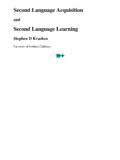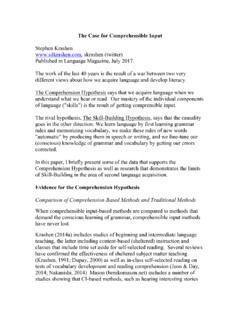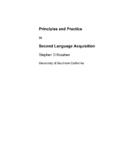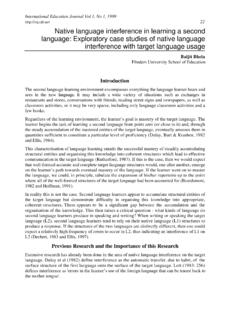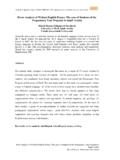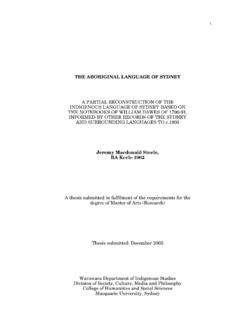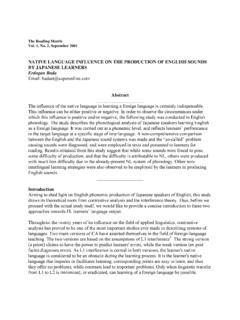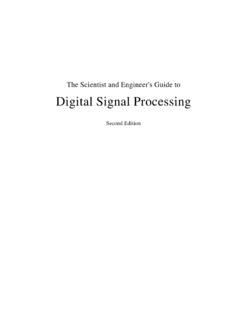Transcription of Comprehensible Output Stephen Krashen
1 Comprehensible Output Stephen KrashenSystem 26: 175-182, 1998 The Comprehensible Output (CO) hypothesis states that we acquire language when we attempt to transmit a message but fail and have to try again. Eventually, we arrive at the correct form of our utterance, our conversational partner finally understands, and we acquire the new form we have produced. The originator of the Comprehensible Output hypothesis, Merrill Swain (Swain, 1985), does not claim that CO is responsible for all or even most of our language competence. Rather, the claim is that "sometimes, under some conditions, Output facilitates second language learning in ways that are different form, or enhance, those of input" (Swain and Lapkin, 1995, p.)
2 371). A look at the data, however, shows that even this weak claim is hard to support. THE SCARCITY ARGUMENT A problem all Output hypotheses have is that Output is surprisingly rare ( Krashen , 1994). In the case of CO, the problem is especially severe. A recent confirmation of the scarcity of Output is Ellis, Tanaka, and Yamazaki (1994), who examined vocabulary acquisition under three conditions, tasks in which EFL students heard (1) "premodified" input (input recorded from a task performed with a native speaker and non-native speaker who could request clarification), (2) interactionally modified input (the non-native students could interact with the native speaker), or (3) unmodified input (input recorded from a native speaker doing the task with another native speaker).
3 Of interest to us here is the finding that "of the 42 learners in the IM (interactionally modified) group, only seven engaged in meaning negotiation. The others simply listened" (p. 211). Even when acquirers do talk, they do not often make the kind of adjustments the CO hypothesis claims are useful in acquiring new forms. Pica (1988) concluded that instances of Comprehensible Output were "relatively infrequent" (p. 45). In her study of ten one-hour interactions between low level ESL acquirers and native speakers (teachers), only 87 potential instances of Comprehensible Output were found, that is, interactions in which the native speaker requested "confirmation, clarification, or repetition of the NNS utterance" (p.)
4 93). These 87 interactions contained only 44 cases in which the non-native speaker modified his or her Output (about four per hour), and of these 44, only 13 modifications involved grammatical form, about one per hour. In Pica, Holliday, Lewis, and Morgenhaller (1989), intermediate ESL acquirers interacted with native speakers. Because the situation in Pica (1988) did not promote negotiation (an interview), some of the conversations in this study were in situations designed to require negotiation and Comprehensible Output . Of 1952 native speaker utterances, 327 were "signals indicating clarification or confirmation of what the NNS had said" (p.
5 74). In reaction to these 327 utterances, the non-native speakers produced 116 responses containing "modified Output ." In other words, they produced Comprehensible Output in response to about 6% of the native speaker's utterances (116/1952).1 Interactions were also contrived to promote negotiation in Van den Branden (1997). Eleven and 12 year old speakers and acquirers of Dutch interacted with peers or with a teacher in an activity in which speakers had to describe a drawing to a partner. In peer-peer dyads, 51 instances of negotiation of meaning were recorded, and of these, the speaker modified their Output 20 times.
6 In peer-teacher dyads, there were 49 instances of negotiation of meaning and 20 instances of alteration of Output . In both cases, this amounted to about one every five minutes. We do not know if the alteration improved the grammatical accuracy of the Output ; we are only told that "these modifications often involved, or included, formal modifications .." (p. 616). Even if every case resulted in improvement, however, this data confirms that even in contrived situations, Comprehensible Output is infrequent. Lyster and Ranta (1997) recorded hours of French immersion language arts and subject matter lessons involving fourth and fifth graders.
7 The lessons contained a total of 3268 student turns, of which about 1/3 (1104, or 34%) had at least one error. While teachers provided some kind of feedback to 62% of these errors, only 73 were in the form of a clarification request, "a feedback type that can refer to problems in either comprehensibility or accuracy, or both" (p. 47). Of these 73, 20 were followed by student repair, or correction. This amounts to about one per hour, a result very close to that reported by Pica (1988) for conversations. In this case, however, only the one student producing the repair had the benefit of Comprehensible Output . The situation in writing is similar.
8 Cumming (1990) examined the think-aloud protocols of second language writers, hypothesizing that instances in which writers appeared to be attending to both form and meaning at the same time are potential instances for language acquisition , according to the Comprehensible Output hypothesis. Only 30% of the verbal reports made by the writers in his sample were of this kind (p. 490). In addition, the nature of the episodes makes it unlikely that they play a major role in language acquisition : Most of the episodes were writers' searching for the right word, or searching for first language equivalents. The latter is the familiar strategy of falling back on the first language when competence is lacking in the second language (Newmark, 1966).
9 In Swain and Lapkin (1995), grade 8 early French immersion subjects were asked to write a short essay in French (one to two paragraphs) and then edit it, and to "think aloud" as they made decisions. For the draft and editing stage combined, there were "190 occasions in which students consciously recognized a linguistic problem as a result of producing, or trying to produce, the target language " (p. 384). This amounts to an average of per student. If students wrote a short essay everyday (which they do not), this would mean about ten chances to improve through writing per day - not very much. As was the case with Cummings' study, many of the decisions were lexical (looking for the right word), not grammatical (50% in the first draft).
10 In addition, Swain and Lapkin note that there was no evidence that any of the episodes they described led to improvement. acquisition WITHOUT Output There are numerous studies that confirm that we can develop extremely high levels of language and literacy competence without any language production at all ( Krashen , 1994). Laboratory studies show that subjects typically acquire small but significant amounts of new vocabulary knowledge from a single exposure to an unfamiliar word in a Comprehensible text (Nagy, Herman, and Anderson, 1985), enough to account for expected vocabulary growth, and similar results have been reported for second language development (Pitts, White, and Krashen , 1989; Day, Omura, and Hiramatsu, 1991; Dupuy and Krashen , 1993).
